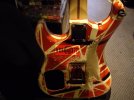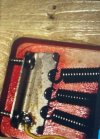I just thought of a question and you seem to be the one to ask. As you know, rumors about Eddie are all over the place.That is a 40 "E" but the rest is just a 9 set and it's not tuned down a half step.

In the early recordings Ed tuned to what sounded right to him with the chords in the rhythm . Live? not.I just thought of a question and you seem to be the one to ask. As you know, rumors about Eddie are all over the place.
Question is, I saw a video of a song tutorial and the guy said Eddie slightly down tuned either his B or G string because he didn't think those two sounded good together tuned normally, is this really a thing he did or just another urban legend? Lol
Just to be clear, I may be backwards one way or the other. Maybe it was the G and was tuned up a little, but still something to do with the tuning of this two strings.
Thanks in advance. I have never heard anyone as knowledgeable as you in so many things "Ed", and when I saw the strings question, that popped back into my mind.
The middle one is sold a while ago but they where all made for me. The body of the first will be for sale soon and I may only keep one but I am not decided. I had only intended to build one but then it got complicated.
This was basically, (exactly?) what the guy said. I did do what he said, and it did sound nicer. At least that particular song.In the early recordings Ed tuned to what sounded right to him with the chords in the rhythm . Live? not.
I am in total awe of his skills, knowledge, dedication, etc. This has been an awesome thread to follow. I was actually getting fidgety the last few weeks with no updates. LolThe dedication is quite impressive. As are the skills and pics.

It is actually pretty common to tune to the part or to the song when recording. For example: if you tune a guitar so your first position A chord is perfecty in tune, playing a D will be a messThis was basically, (exactly?) what the guy said. I did do what he said, and it did sound nicer. At least that particular song.
Poplar doesn't always in every plank have the green streaks and yes this is a good identification method . Basswood also sometimes has very similar grain. The holes and sometimes the pickup routs were done at Kramer to allow flexibility. The question of how did a non stock wood pacer end up at Kramer has a few answers. The first is Kramer had just stopped using maple for the body and requested a lighter (but also cheap) alternative. They may have sent samples in different light woods. I have seen a half poplar half alder pacer but your right the stock was poplar. 5150 is a very light body, under 3 1/2 lb body unloaded and it is only partially finish sanded . An explanation for swamp ash is the same; an unfinished sample laying around until someone picked it up and finding it to be very light decided to use it for Ed. No special order Sports bodies are known.I know the 5150 is a Pacer Special body. Do you know if the tone and mini switch holes had to be filled or were the controls drilled at the Kramer facility?
On the subject of the wood, poplar can have some ugly green tinting in it. Basswood tends to be pretty plain and even coloring. It seems you could get a good idea on the back where the paint is missing. The first time I started hearing about basswood was the late 80’s when the Ibanez Jems and RG’s started coming out. It didn’t seem to be a very common wood in guitars in the early 80’s. Doesn’t seem likely Kramer would have a basswood body laying around unless Ed told them he wanted one in advance so they could order it.





Classic mission creep, but sometimes it's just so fun to go down the rabbit hole. Either way it's been a blast following the thread and now I'm tempted to swap out the pup in my single H Strat from a SD Pearly Gates to a SD CCJI had only intended to build one but then it got complicated.
The other points for basswood are:Thanks for the pictures, Andy. I saw someone make a case for basswood a couple years ago. They cut a body and the forearm cut had the same open grain pattern as Ed’s. Don’t remember who or where I seen it. Could have been at VHND but I’m not sure. I was very surprised that basswood could do that. I was convinced that it was basswood but following your investigation it’s hard to say without seeing the guitar in person. The back doesn’t look like ash. The face doesn’t look like ash. Only that forearm cut and that little spot by the pickup you pointed out but as I said before, I’ve seen examples that basswood can do that. Also inside the cutaways there would be a lot of open grain if it was ash and hadn’t been filled. I’m leaning towards basswood but for the times it wasn’t a very common wood. However. it was used as you pointed out Holdsworth.
Was that only a rumor? There used to be an official 5150 string set (Ernie Ball, I think) that were 9-40. I used them for a while because I preferred the 40 low E and the 15 G string.I’m freaking blown away. What strings are you using? Are you doing the rumored 9-40 set?
Early on, Ed used Fender 150 .009 strings that were 9-40. I used the same ones, too. That’s why those early 5150 strings were the same gauge.Was that only a rumor? There used to be an official 5150 string set (Ernie Ball, I think) that were 9-40. I used them for a while because I preferred the 40 low E and the 15 G string.
Wasn’t the original EB prototype that Ed used to finish the F.U.C.K. album a solid unfinished basswood without the maple top? I seem to remember that from an interview. Your point makes sense. Your work is top notch, btw. Thanks for sharing your journey of this.The other points for basswood are:
Scott (musikraft) says it is.
The fact that when music man made the prototypes for Ed to replicate the tone of 5150 ALL of them were basswood and they had 5150 to work from.
Every guitar after made for Ed is basswood .
All the backup Kramer guitars from 5150 on are basswood (I have disassembled some.)
The ripped out screws hooks, failed post holes and crushed neck plate are all typical for basswood.
Was that only a rumor?
